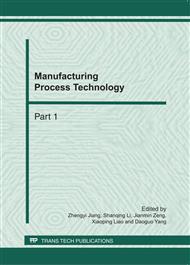p.1926
p.1930
p.1934
p.1941
p.1946
p.1955
p.1960
p.1964
p.1969
Numerical Simulation of Effect of Slip Conditions on PVC Co-Rotating Twin-Screw Extrusion
Abstract:
The effect of wall conditions on the co-rotating parallel twin-screw extrusion of rigid polyvinyl chloride (RPVC) is studied. The relationship between the shear stress at the screw wall and the slip velocity of the flowing melt obeys Navier’s linear law. At zero pressure difference between the entrance and exit of the melting section of twin-screw extruder, the volumetric flow rate and 3D isothermal flow fields of RPVC are calculated under different wall slip conditions in the metering section of the twin-screw extruder by using the evolution technique in POLYFLOW. The results show that when the slip coefficient is smaller than 104Pa*s/m , the volumetric flow rate of the melt is constant, corresponding to the full slip condition. When the slip coefficient is larger than 104Pa*s/m , with the slip coefficient decreasing, the volumetric flow rate and viscosity increase, but the gradients of velocity, pressure, and shear rate decrease. The residual stress of the product is thus reduced. Therefore, increasing wall slip is good for the stability of polymer extrusion and the product quality. The dispersive and the distributive mixing of the twin-screw extruder under full slip and no slip conditions are also studied. Results show that the mixing performance under no-slip condition is better than under full-slip condition, but slip at the wall is good for the extrusion of heat-sensitive materials.
Info:
Periodical:
Pages:
1946-1954
Citation:
Online since:
February 2011
Authors:
Price:
Сopyright:
© 2011 Trans Tech Publications Ltd. All Rights Reserved
Share:
Citation:


